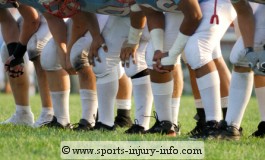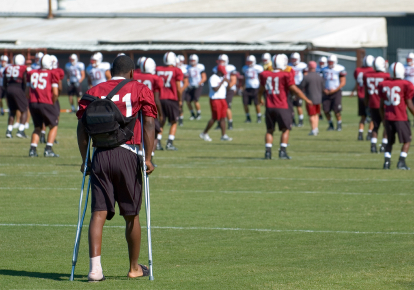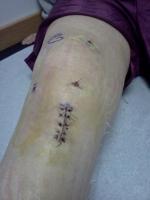Sports Injury Rehab Basics
Sports injury rehab is vital for a full and speedy recovery. Regardless of the type of injury, or the severity, some form of rehabilitation is necessary in order to get back to your activities pain free and at full performance.
Successful management of sports injuries requires appropriate initial treatment AND a good rehabilitation program. From ACL tears to minor ankle sprains, a good rehabilitation program will make the difference between a speedy and successful recovery, or a chronic, nagging problem.
Rehab vs. Treatment
I like to think of the recovery process as having three distinct phases or processes. The first is the initial treatment of the sports injury. This includes getting a proper evaluation and diagnosis, treatments to control the initial pain, inflammation, and dysfunction that results from the injury, and protecting the damaged tissues so that they can begin to heal. Rest, ice, compression, protected mobilization, and bracing are all considered initial treatments.
After the injury is managed acutely, the next process or phase is that of rehabilitation. This is when you work to restore normal function to your injured body part. Rehab focuses on improving mobility, neuromuscular control, stability, and normal movement patterns. The sports injury rehab process can last for a few days to several months depending on the injury and how severe it is.
The third phase or process is the return to play / performance enhancement. This could be seen as the late phase rehabilitation process, but I like to think of it as what you are doing after you are back to playing, but still working to regain your normal form and function.
Sports injury rehabilitation is based on
several different things. The key is to return the body to normal
function. Depending on the type of injury, there can be lots of
different areas of dysfunction. The most common of these are mobility
restrictions, strength deficits, and balance deficits.
Keys to Successful Sports Injury Rehab
There are two primary goals of rehabilitation. The first is to restore normal mobility to the body. Every joint has a normal range of motion that allows it to function efficiently. If this mobility is restricted, it changes the normal movement patterns of the joint, it changes the stress that is placed on the joint and other tissues, and it changes the way the muscles around the joint work. Mobility can be restricted by swelling, soft tissue contractures and adhesions, tight muscles, or a variety of other factors. It is essential that you restore normal mobility BEFORE you try to strengthen the muscles or retrain movement patterns. Mobility is the first Key to successful rehabilitation.
The second key to sports injury rehab is restoring normal stability and neuromuscular control. Each joint relies on muscles in order to maintain dynamic stability. When those muscles are working correctly, they contract and relax during movement to keep the joints stable. But, when we have injuries we often see deficits in muscle function, which leads to instability and compensations. Once you restore mobility, you have to re-train the body to control those motions and remain stable. Stability is the second key to successful rehabilitation.
Once normal mobility and stability are restored, you can then begin to work on improving movement patterns and the overall function of the body.
The
resources below are just a few of the ways that you can work to correct
mobility, stability, and movement pattern deficits in the body. They can be used within a rehabilitation program, or as exercises to prevent injury.
Mobility Exercises
- Sports Injury Rehab: Improving
Flexibility
Improving flexibility is the easiest and most common way to fix mobility restrictions in the body. Learn more about improving flexibility. - Hamstring
Stretches
The hamstrings are probably the tightest muscles in the body. Just about everyone has mobility restrictions and could use a little stretching. These are just a few of my favorite hamstring stretches. - Hip
Stretches
The hip flexors and the iliotibial band are two muscles in the hip that can often cause mobility restrictions. Learn how to stretch them. - Piriformis
Stretches
The piriformis muscles is one of the major problem muscles of the hip. It can lead to rotation restrictions as well as other problems. Learn how to stretch it. - Calf
Stretches
Stretching the calf can be a great way to prevent or treat lower extremity injuries - ankle sprains, plantar fasciitis, achilles tendonitis, and others. Learn how to stretch the calf. - Foam
Roller Exercises: Improving Mobility
Learn how to use a foam roll to improve your flexibility.
Stability Exercises
- What
is Proprioception?
Other than a big word, it is the key to balance and muscle function. Find out more about proprioception and how it relates to sports injury rehab and sports performance. - Balance
Exercises
Simple balance exercises can significantly improve sports performance, as well as get you back from an injury. Learn more about balance exercises for sports injury rehab. - Core
Exercises
Core stability is vital for athletic performance. Lack of core strength is a major factor in many overuse injuries. Learn more about the importance of abdominal strength. - Lower
Abdominal Exercises
The lower abdominals are responsible for stabilizing the pelvis. Which in turn stabilizes the entire lower extremity and the lower back. Learn how to strengthen the lower abdominals. - Push
Ups
Without the use of equipment, the push up is one of the best exercises you can do. It works the core, the arms, shoulder, and back. Learn about this versatile exercise and some simple variations for perfect push ups. - Abdominal
Plank
The abdominal plank, when done correctly is a fantastic way to work the abdominals and the core. Learn this exercise and some of its variations. - Fitness
Ball Exercises
The fitness ball, or swiss ball is a great tool to use to improve strength. It is especially useful to improve core stability and strength. Learn some of the most common fitness ball exercises. - Foam
Roller Exercises: Core Strength
A foam roll is an inexpensive tool that can help you improve core strength and flexibility. - Lunges
Lunges are a great way to improve strength of the lower extremity, especially the quadriceps, hamstrings, hips, and core. Learn some of the variations on this basic exercise I use with my patients everday.
- Elastic Band Walks
Band walks are a great way to improve hip strength, especially in the abductors and external rotators. This is a great exercise for patella femoral syndrome, as well as general hip strengthening.
Sports Injury Rehab For Specific Conditions
- Knee
Rehab
Knee rehab must focus on many different areas to be successful. Learn what your program should consist of and make sure you are on the right track to recovery. -
ACL Injury Solutions
A comprehensive strength, balance, and muscle control program designed to help protect your ACL.
- Patella
Femoral Syndrome Rehab
Learn the basics of patella femoral rehab, and what you should be doing to treat your knee pain.
- Patella
Femoral Solutions
A comprehensive strengthening, balance, and mobility program designed specifically for eliminating knee pain from patella femoral syndrome.
-
Hamstring Treatment
Hamstring treatment and rehab must focus on fixing the underlying problems that caused your injury. Learn more about the basic components of a good hamstring rehabilitaiton program.
- Ankle
Rehab
Rehabilitation of the ankle, whether after a sprain or surgery needs to include range of motion, strengthening, and balance exercises. Learn the basics of ankle rehab. - Shoulder
Rehab
Shoulder rehab should be specific to your injury, yet must contain several main factors to be effective. Learn what a good shoulder rehab program consists of. - Elbow
Rehab
Learn about elbow strengthening, range of motion, and proper mechanics with a complete elbow rehab program.
Please remember that although the exercises above have been used by myself to successfully treat hundreds of patients, they should not be used instead of proper medical evaluation, treatment, and rehabilitation by a qualified healthcare professional. If you have an injury and are in need of rehabilitation, please see your physician, athletic trainer, or physical therapist.
SII › Sports Injury Rehab


